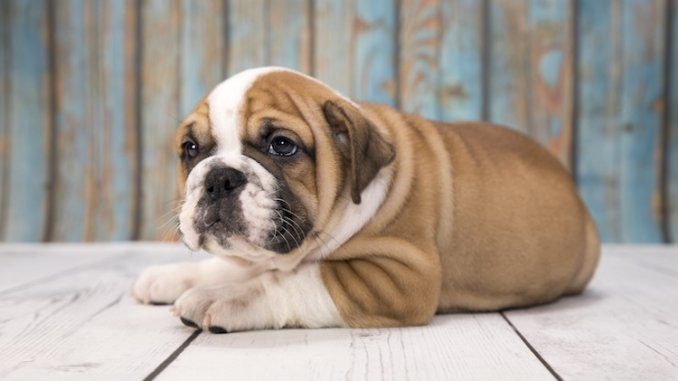
A selectively bred variety of the widely known English Bulldog, the Victorian Bulldog is a much healthier breed that has all of the lovable charm of its predecessor.
They were originally bred by Ken Mollett in an attempt to return the English Bulldog to its taller, more robust form of the 1800s.
Short, round, and wrinkly the Victorian Bulldog has a bold look that you can’t help but love.
Their grumpy faces may look intimidating, but they are very gentle dogs which make great family pets.
Relatively low maintenance and hearty, this breed is suitable for anyone looking for an easygoing companion.
If you are interested in bringing home one of these quirky dogs, keep reading to find out everything you need to know about their history and care requirements.
TABLE OF CONTENTS
Victorian Bulldog – Breed Origin & Overview
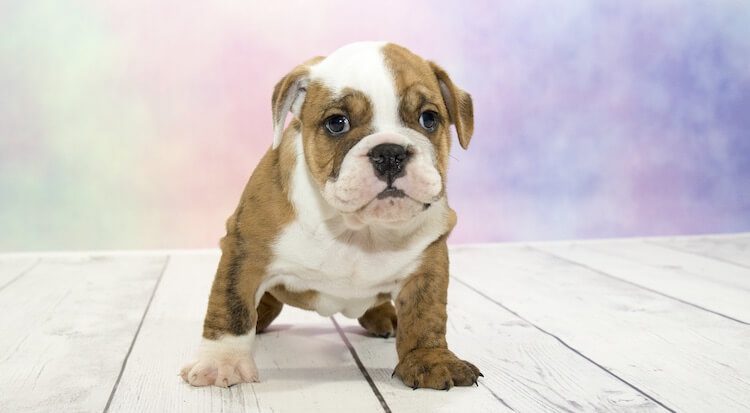
Though their burly appearance and muscular body may say otherwise, the Victorian Bulldog is a companion dog through and through.
While they do best in mild climates, with no extreme heat or cold, these dogs adapt well to country or city life as long as they can be exercised regularly.
When this breed is is not lounging around, or hanging out with the family, they make vigilant guard dogs; large teeth and a deep bark are sure to make any intruder think twice about entering.
Kennel Club Recognition
Unfortunately, Victorian Bulldogs not yet recognized by any major Kennel Club, so they do not have a traditional breed classification. If it did, it would likely be in the non-sporting group; like its English Bulldog cousin.
This is most likely because they are a very recent and rare breed.
Ken Mollett only began breeding this canine in the 1980s, so they have not yet achieved the required consistency in appearance and temperament to receive the recognition of any kennel club.
Currently, there are only two minor registries which acknowledge this breed:
- American Canine Association
- Dog Registry of America
There are many rescue organizations for Bulldogs, including the Bulldog Rescue Network.
However, to be sure your new companion is an authentic Victorian Bulldog, you will need to undertake significant research into the breeder or purchase one directly from the original breeder’s family in the UK (more on this below).
Breed Origin
To learn about the origin of the Victorian Bulldog, we need to take a look at its cousin; the English Bulldog.
Unfortunately, their adorable short, stocky bodies and iconic wrinkles have contributed to the breed’s overall health decline.
High demand and increased breeding have led to exaggerated features that created many health issues, including skin infections, respiratory problems, and skeletal deformities to name a few.
Ken Mollett, an enthusiast from London, wanted to produce a healthier, more athletic English Bulldog so he created the Victorian Bulldog by mating:
- Staffordshire Bull Terriers
- Bullmastiffs
- Bull Terriers
- English Bulldogs
He based this new breed after the traditional Bulldogs of the 1800s which were slightly taller, had a slightly longer snout, and shallower wrinkles.
Victorian Bulldogs are highly sought after, but they are extremely rare, they only recently made their way to America in the past decade.
| Size | 16 to 18 inches for females and 17 to 19 inches for males |
| Weight | 55 to 65lb for females and 65 to 75lb for males |
| Lifespan | 12 to 14 years |
| Breed Type | Non-Sporting Group |
| Purpose | Companion Dog |
| Suitable For | Families Or Single Owners |
| Color Variations | Red, White, Brindle, Or Fawn |
| Temperament | Calm, Playful, Loyal, Friendly and Gentle |
| Other Names | Ken Mollett Victorian Bulldog |
Victorian Bulldog Puppies
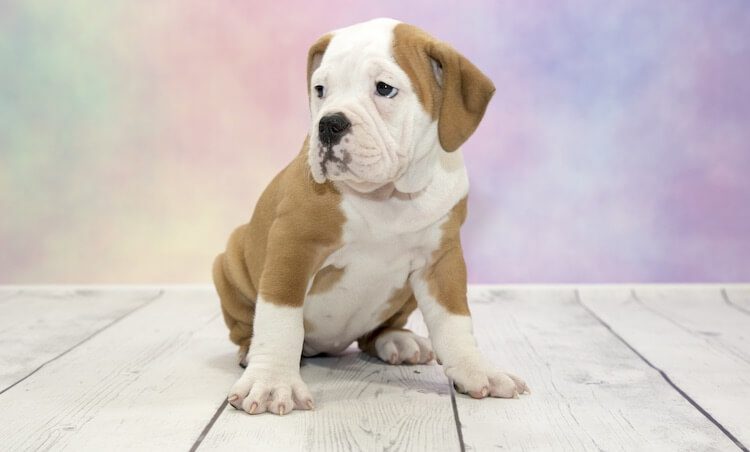
Many breeders incorrectly advertise their dogs as Victorian Bulldogs when they are just English Bulldogs hybrids.
Litter sizes average from between three to six puppies and you can expect to pay anywhere between $1,300 and $2,000 USD to bring a Victorian Bulldog puppy home.
Puppies will weigh around 10 pounds at 8 weeks old, when they are ready to head to their new homes.
It will take them anywhere from 1 to 2 years to reach their adult size and weight; during that time their bone structure and wrinkles will change considerably:
| 3 Months | 15 – 20 |
| 6 Months | 30 – 40 |
| 9 Months | 40 – 50 |
| 12 Months | 50+ |
Victorian Bulldog Temperament
This is a breed that thrives on and demands attention from everyone they meet.
Consequently, if left alone for too long they may become destructive and chew furniture or leave messes throughout the house.
If you don’t have lots of time to offer, the Victorian Bulldog is not the breed for you.
Although generally quiet and reserved, this dog has an intimidating bark that they will use to alert you to any suspicious activity, whether it be an unwelcome animal in the yard or a home invader.
Victorian Bulldogs don’t have a prey drive, like some other breeds, but are still prone to chasing the occasional lizard or squirrel that comes into their territory.
This breed may be protective of its family, but should never be aggressive without cause.
To prevent aggresion, early socialization and training are required to ensure an obedient and calm dog in any situation.
While Victorian Bulldogs are extremely gentle with their family and guests, they are effective guard dogs.
These dogs are good at distinguishing from an intruder or guest and can even be trained to recognize and alert you to specific threats.
Personality
Though they don’t have the stamina required for long outdoor hikes, this breed is always ready for an adventure.The Victorian Bulldog is a lively, yet dignified puppy that is up for anything.
Their playful nature and robust build make them excellent playmates for older children, and they are great at being gentle and calm with younger children too.
When this breed isn’t playing or chasing squirrels in the yard, you’ll find them lazing the day away on the couch or trying to curl up in your lap!
Compatibility with Families
Upon introducing your dog to the family, you may find that they are instantly drawn to any children.
Victorian Bulldogs make fantastic family pets and will spend every minute getting into antics with smaller family members.
While you should never have problems with aggression, it is important to teach younger children boundaries and limits to keep your dog comfortable and happy.
They are great at making friends with animals they meet, whether it be other dogs or even cats. Beginning to introduce your dog to as many new animals as possible early on is key to developing social skills.
Overall, this is a very adaptable breed that will enjoy the company of every member of the family.
Victorian Bulldog Appearance
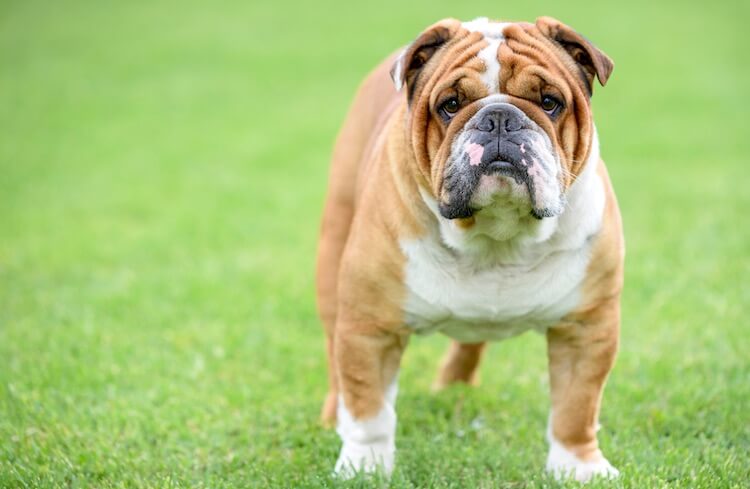
Victorian Bulldogs are recognizable by their short yet muscular stature.
Since the breed is not recognized by any major kennel club, the breed standard was set by Ken Mollett and is adhered to by those currently breeding the dogs.
Additionally, the teeth of this Bulldog should not meet in an underbite and their bodies should be lean and never rotund in any way.
Size
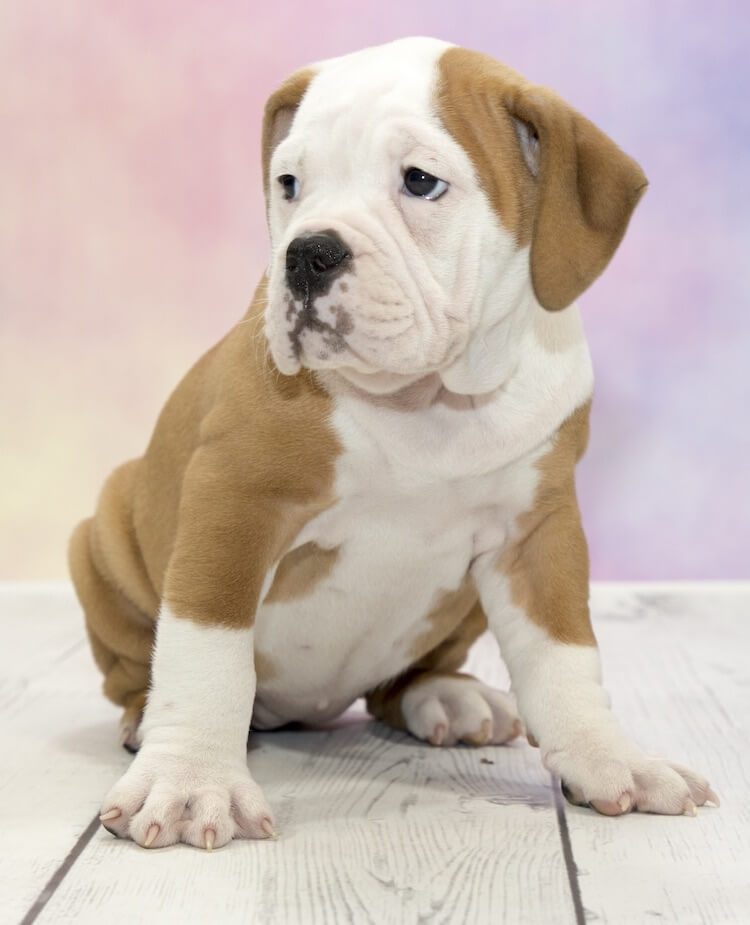
From Adobe Stock
The average size for this breed is 65-75 pounds for males, and 55-65 pounds for females.
Males’ height averages 17-19 inches while females are slightly smaller at 16-18 inches.
They are generally considered medium to large sized dogs depending on their full adult size.
Color
Victorian Bulldogs come in a variety of colors including:
- Brindle
- Fawn
- Red
- White
They are never black, or any combination of black and another color.
Coat
Victorian Bulldogs have very short straight coats, typical of their Bulldog cousins.
The fur is single coated and dense throughout the entire body. Color varies widely but the most common and desired is red or white.
They shed an average amount of hair, but have a heavy shedding season two times a year.
Regular brushing and grooming can help keep shedding to a minimum but won’t completely stop it.
Grooming
To keep your furry friend clean and comfortable, twice weekly brushings with a soft bristled brush are recommended.
Full baths are only required about once a month or as often as your dog gets dirty, but never bathe more than once a week to avoid dry, itchy skin.
Haircuts are not necessary for this breed as they have very short fur that won’t grow to be long.
Though the Victorian Bulldog’s wrinkles are not deep, it is still very important to check and clean them regularly to prevent build up and skin infections from occurring in the rolls.
Brushing your dog’s teeth a minimum of 2-3 times a week is vital to maintain your dog’s dental health and avoid expensive vet bills.
Victorian Bulldog Care Guide
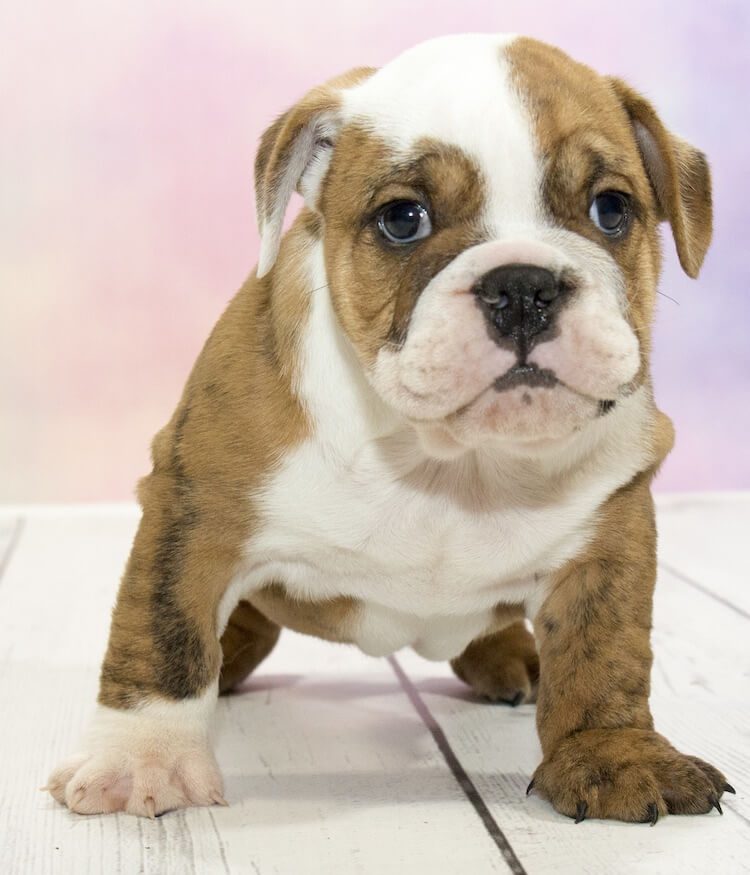
From Adobe Stock
Unlike their English cousins, the Victorian Bulldog requires much less maintenance to be happy and healthy.
However, they don’t like to be left alone, and require a significant amount of effort to train, so they may not be best suited to first time dog owners.
Food and Dietary Requirements
| Daily Food Consumption | |
|---|---|
| Guide | 1,000 calories |
| Cups of Kibble | From Adobe Stock |
Feeding your Victorian Bulldog is pretty straightforward.
They do well on any high quality dog food whether it be: dry, raw or wet.
However, it is extremely important not to overfeed or give too many treats to this breed as they can become overweight very easily and develop joint problems among other issues.
Victorian Bulldogs should eat ¾-1 cup of high-quality kibble, one in the morning and one at night.
This is better for their digestive system and keeps them excited for mealtimes. Since every dog is different, it is always recommended to consult your veterinarian about the best meal options for your pooch.
Exercise Requirements
| Daily Exercise Requirements | |
|---|---|
| Minutes | 20 to 30 minutes |
| Activity Level | From Adobe Stock |
Though this breed can be a very playful, they definitely prefer a slow-paced life.
A 20 to 30 minute walk once or twice a day is all that’s needed to satisfy their exercise requirements.
This makes them easily adaptable to living in an apartment or small home.
They may not be ideal hikers, but your dog will love chasing after balls or frisbees outside. Supervised swimming (ideally with a life jacket) is also a great low impact exercise they might enjoy.
When going out for a walk, a correctly fitted harness and leash is recommended to keep your dog under control.
Training
When beginning to train your Victorian Bulldog, it is important to begin as early as possible and to establish a routine.
Their loyal and loving nature lends itself perfectly to positive reinforcement methods. Clicker training can be a great way to teach your dog basic commands while keeping training a positive experience.
This Bulldog is very intelligent and will really benefit from puzzle games and boredom busters.
A good way to keep them entertained while you’re out is to stuff a puzzle toy with part of a meal and give it to them as you leave the house.
Health Problems
The Victorian Bulldog’s main difference from their English cousins is their lack of health issues.
It is a relatively healthy breed, and with proper care and regular vet visits, you should be able to enjoy your dog with few complications.
However, their stocky size still makes them prone to hip and elbow dysplasia as well as weight gain.
Though hip dysplasia is not something that can be prevented, closely monitoring how much your dog consumes can keep their weight under control.
Additionally, these Bulldogs are extremely sensitive to temperature changes as they can overheat easily and have trouble cooling down.
If you live in a place where extreme weather is common, this canine is not for you.
Summary
The Victorian Bulldog is a loyal and affectionate breed suited to an individual or family with lots of time and love to give to this amazing breed.
They are probably not the breed for you if it is your first time training a dog or if you live in an especially hot or cold climate.
Gentle, playful, and protective, this is a wonderful dog to add into a growing family.
Though they love to lounge, moderate exercise and mental stimulation indoors or outdoors is important to keep your new friend healthy and fit.
So, if you’re able to provide a loving home, you’ll find that you have a very silly, wonderful new best friend.

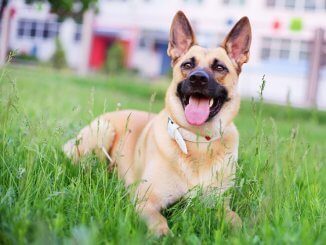
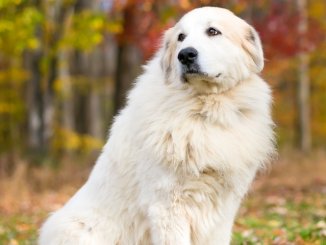
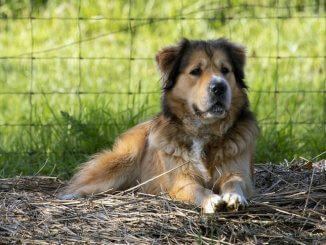
Be the first to comment